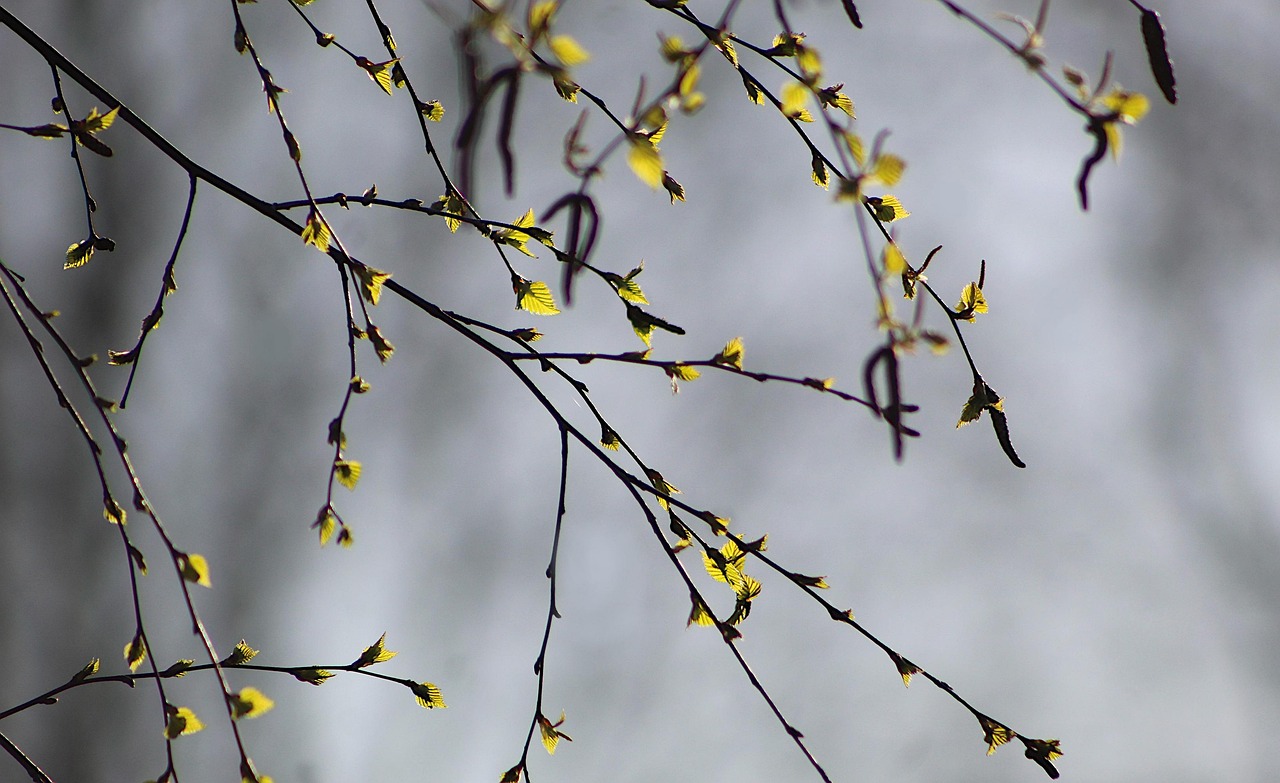Aspen and birch trees are both members of the Betulaceae family, but they can be identified by distinct characteristics. Aspens typically have smooth, white bark with black knots and heart-shaped leaves, while birches feature darker, peeling bark and triangular leaves. Their growth habits and ecological roles also differ significantly.
Understanding the differences between aspen and birch trees is essential for both amateur and professional botanists. These trees are prevalent in many regions and play significant roles in their ecosystems. Besides their ecological importance, they also have unique aesthetic qualities that make them popular in landscaping and gardening.
Aspen trees, primarily belonging to the genus Populus, are known for their ability to thrive in various environments. They are often found in clusters, as they reproduce through root sprouts. This characteristic allows them to form extensive groves, which are stunning to behold, especially during autumn when their leaves turn vibrant shades of yellow.
On the other hand, birch trees belong to the genus Betula. They are often recognized for their striking bark, which peels away in thin layers, revealing a lighter inner bark. Birches tend to grow taller than aspens and can live longer, with some species reaching over 100 years of age. Their wood is highly valued for its strength and beauty.
Key Characteristics

Here are some of the key characteristics that differentiate aspen and birch trees:
| Characteristic | Aspen Trees | Birch Trees |
|---|---|---|
| Bark Color | Smooth white with black knots | Pale or silver peeling bark |
| Leaf Shape | Heart-shaped | Triangular |
| Growth Habit | Clonal groves through root sprouts | Single or clustered trunks |
| Lifespan | 30-50 years | Up to 100 years or more |
Both tree types also have specific environmental preferences. Aspens prefer cooler climates and are commonly found in mountainous regions. They often dominate early successional forests after disturbances like fire or logging. In contrast, birches can adapt to a wider range of soil conditions and are often found in both wet and dry areas.
In terms of wildlife, aspens are crucial for various species. Their leaves are a food source for insects, which in turn attract birds. Birch trees also support a variety of wildlife, including birds that nest in their branches and insects that feed on their foliage.
Environmental Benefits of Aspen and Birch Trees
Both aspen and birch trees offer numerous environmental benefits that contribute significantly to their ecosystems. Their unique characteristics not only enhance biodiversity but also promote soil health and improve air quality.
Carbon Sequestration
Aspens and birches are highly effective at sequestering carbon dioxide from the atmosphere. Through the process of photosynthesis, these trees absorb carbon dioxide and convert it into oxygen, playing a crucial role in mitigating climate change.
- Aspen Trees: Due to their rapid growth rate, aspens can absorb large amounts of carbon, especially in their early years. This makes them valuable in reforestation efforts.
- Birch Trees: Birches also contribute to carbon sequestration. Their longevity allows them to store carbon for extended periods, further enhancing their ecological impact.
Soil Improvement
The root systems of both aspen and birch trees help stabilize soil and prevent erosion. They play a key role in maintaining soil structure and fertility. Here are some specific ways they contribute:
- Root Structure: The extensive root systems of these trees bind the soil together, reducing the risk of erosion in areas prone to heavy rainfall.
- Nutrient Recycling: As leaves fall and decompose, they enrich the soil with organic matter, improving its nutrient content and promoting healthy plant growth.
Ecological Interactions
Aspens and birches create habitats that support various forms of wildlife. Their presence in a landscape fosters interactions among different species, contributing to a balanced ecosystem.
Habitat for Wildlife
The foliage and structure of these trees provide shelter and food for many animals. Here are some examples of wildlife interactions:
- Bird Species: Many birds, such as warblers and woodpeckers, rely on aspen and birch trees for nesting sites. The presence of these trees increases bird diversity in an area.
- Mammals: Small mammals like squirrels and larger herbivores such as deer often feed on the leaves, buds, and bark of these trees.
- Insects: Various insect species thrive in the habitats created by aspen and birch trees, serving as essential food sources for birds and other predators.
Symbiotic Relationships
Aspen and birch trees also engage in symbiotic relationships with various fungi and microorganisms in their ecosystems. These interactions enhance their growth and resilience:
- Mycorrhizal Fungi: Both tree types often form associations with mycorrhizal fungi, which help them absorb water and nutrients more efficiently from the soil.
- Bacterial Associations: Nitrogen-fixing bacteria may associate with the roots of these trees, enriching the soil with nitrogen and promoting healthier growth.
Uses of Aspen and Birch Trees
Aspen and birch trees are not only valuable for environmental reasons; they also have various practical applications that benefit humans.
Wood Products
The wood from both tree types is highly sought after for its unique properties:
- Aspen Wood: Light in color and weight, aspen wood is often used for making furniture, paper products, and even musical instruments due to its fine grain.
- Birch Wood: Birch wood is known for its strength and attractive appearance. It is commonly used in cabinetry, flooring, and decorative veneers.
Cultural Significance
Aspen and birch trees also hold cultural importance in various communities. They are often featured in art, literature, and traditional practices:
- Indigenous Cultures: Many indigenous peoples have utilized birch bark for making canoes, baskets, and other functional items throughout history.
- Modern Art Forms: Both tree types inspire artists due to their beauty and symbolism, often representing resilience and adaptability.
Identification of Aspen and Birch Trees

Identifying aspen and birch trees involves observing several physical characteristics, including bark texture, leaf shape, and overall growth patterns. Recognizing these features can help differentiate between the two tree types, even for those new to botany.
Bark Characteristics
The bark of aspen and birch trees varies significantly, making it one of the most noticeable identification factors.
- Aspen Bark: The bark is smooth and white, often marked with black knots. This distinctive appearance helps in easily identifying aspens in forests.
- Birch Bark: Birch trees feature thin, peeling bark that can be white, yellow, or even dark brown, depending on the species. The peeling nature adds to its unique visual appeal.
Leaf Characteristics
Examining the leaves is another effective way to distinguish between aspen and birch trees.
- Aspen Leaves: The leaves are heart-shaped and typically have a finely serrated edge. They are bright green in spring and summer, turning vibrant yellow in the fall.
- Birch Leaves: Birch leaves are more triangular with serrated edges. They are usually a darker green compared to aspen leaves and can also turn yellow in autumn.
Growth Patterns and Habitat Preferences

The growth patterns and habitat preferences of aspen and birch trees further assist in their identification. Understanding where each tree typically grows can provide additional clues.
Growth Patterns
Aspen trees tend to grow in clusters due to their ability to reproduce through root sprouts. This clonal growth leads to extensive groves that can cover large areas.
In contrast, birch trees generally grow as single trunks or in small groups. They are taller than aspens and can reach heights of over 100 feet, depending on the species. Observing the arrangement of the trees can also help in identification.
Habitat Preferences
Aspen trees thrive in cooler climates and are often found in mountainous regions or areas that have recently experienced disturbances like fire. They prefer well-drained soils and can tolerate a variety of soil types.
Birch trees, on the other hand, display more versatility in habitat preferences. They can grow in both wet and dry conditions, making them common in various environments, including swamps and upland forests.
Seasonal Changes and Phenology
Seasonal changes significantly affect the appearance of aspen and birch trees. Observing these changes can aid in identification throughout the year.
Spring and Summer
During spring and summer, both trees exhibit lush green foliage. Aspens produce clusters of small catkins that hang from the branches, while birches develop elongated catkins that can be more visually prominent.
Autumn Colors
As autumn approaches, the leaves of both trees transform dramatically:
- Aspen Trees: The leaves turn brilliant shades of yellow, often creating stunning landscapes when viewed in large groves.
- Birch Trees: Birch leaves typically change to a golden yellow. The contrast between their white bark and yellow leaves creates a striking visual effect.
Winter Identification
In winter, identifying these trees becomes more challenging but still possible. The smooth white bark of aspens stands out against the winter landscape. For birches, the peeling bark remains distinctive. Observing the structure and branching patterns can also assist in identification during this season.
By understanding these identifying characteristics and seasonal changes, individuals can become adept at distinguishing between aspen and birch trees throughout the year. This knowledge not only enhances appreciation of these beautiful trees but also fosters a deeper connection to the natural world.
Challenges and Considerations in Managing Aspen and Birch Trees

Managing aspen and birch trees involves understanding their unique growth habits, ecological roles, and potential challenges. Both tree species can contribute to a healthy ecosystem, but they also face threats that require careful management.
Pest and Disease Management
Both aspen and birch trees are susceptible to various pests and diseases that can affect their health and longevity.
- Aspen Pests: Common pests include the aspen leaf miner and various beetles that can cause damage to leaves and bark. Regular monitoring and integrated pest management strategies are essential to mitigate these threats.
- Birch Pests: Birch trees often face challenges from birch borers and aphids. These pests can weaken trees and make them more susceptible to diseases. Preventive care and timely interventions can help maintain tree health.
Environmental Threats
In addition to pests, environmental factors also pose risks to aspen and birch trees. These threats can include climate change, invasive species, and habitat loss.
- Climate Change: Changes in temperature and precipitation patterns can impact the growth and health of both tree types. For instance, drought conditions may stress aspen groves, while excessive moisture can lead to root rot in birches.
- Invasive Species: Invasive plants can outcompete native species like aspen and birch for nutrients and sunlight, hindering their growth. Managing invasive species is crucial for preserving the natural habitats of these trees.
- Habitat Loss: Urban development and deforestation reduce the natural ranges of aspen and birch trees. Conservation efforts are necessary to protect their habitats and ensure their survival.
Community Engagement and Education
Engaging communities in the appreciation and preservation of aspen and birch trees is vital for fostering a connection to nature. Educational programs can help raise awareness about the ecological importance of these trees.
Educational Initiatives
Local governments, schools, and environmental organizations can collaborate on educational initiatives that emphasize the value of aspen and birch trees:
- Workshops: Organizing workshops on tree identification, care, and the role of trees in ecosystems can empower community members.
- Tree Planting Events: Hosting community tree planting events encourages residents to actively participate in reforestation efforts, especially for native species like aspens and birches.
- Nature Walks: Guided nature walks can help people learn about local flora, including aspen and birch trees, enhancing appreciation for the natural environment.
Final Thoughts
Aspen and birch trees are vital components of many ecosystems. Their unique characteristics, growth patterns, and environmental benefits make them essential not only for biodiversity but also for human enjoyment. By understanding how to identify these trees, appreciate their role in the environment, and engage in their conservation, individuals can foster a deeper connection with nature.
Their beauty throughout the seasons, from lush green leaves in summer to stunning autumn colors, captivates many. Moreover, the wood products derived from these trees are valuable resources that highlight their economic importance. As we face environmental challenges, it becomes increasingly important to manage these species thoughtfully while also educating future generations about their significance.
Ultimately, both aspen and birch trees remind us of the intricate relationships within ecosystems. By protecting these trees, we are also safeguarding the myriad species that rely on them, ensuring a healthy environment for years to come.
